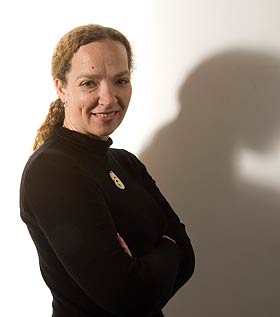

Professor Lisa Matisoo-Smith
“We want to establish the nature of the contact with the island. Was it actually Polynesians settling on this island and establishing a settlement or was it just male traders going back and forth?”
A surprise find of human remains with distinctly Polynesian characteristics in a South American museum has provided a new focus of research into human migration in the Pacific and how the Pacific was settled.
Until now Professor Lisa Matisoo-Smith (Anatomy and Structural Biology) and her research group have been concentrating on using the DNA of dogs, pigs, rats and chickens – animals the Polynesian explorers carried in their colonising canoes – as a ways to track the movement of humans eastwards across the Pacific.
“It was chicken bones found in South America in a pre-Columbian context that got us focusing on that end of the Pacific expansion and we found that they have the same DNA as chickens in the Pacific.
“The bones were directly dated using radiocarbon dating and we found that they were, indeed, pre-Columbian. This was the first evidence of probable Polynesian introduction of something from the Pacific to the Americas,” she says.
“We know that Polynesians picked up sweet potato from the Americas and brought it to the Pacific, but there was never anything showing the arrival of Polynesians there.
“So that led us to look for more evidence of Polynesian contact with South America and, while I was there looking for animal bones, we found a collection of human remains in a museum. One look at these skulls suggested to me they were Polynesian.”
All the skulls were from Isla Mocha, just 30 kilometres off the coast of Chile, so Matisoo-Smith wants to know whether they were part of an exploratory or even migratory group, or were they simply a few individuals taken on a European ship?
She and her group have a Marsden Fund grant to return to the island to excavate for other evidence of Polynesian settlement, such as animal bones or other resources that could have been carried, such as basalt and obsidian for stone tools.
“We want to establish the nature of the contact with the island. Was it actually Polynesians settling on this island and establishing a settlement or was it just male traders going back and forth?”
They will also look at the ancient DNA of any animal and human remains that they find and do chemical sourcing on any artifacts to see whether they're of Pacific origin.
Until recently most ancient DNA research has traced mitochondrial DNA, a maternally inherited marker, but technical advances in DNA capture and sequencing now mean male lines can be followed through Y chromosome DNA. Matisoo-Smiths's group has a new state-of-the-art ancient DNA laboratory and, combined with the latest next-generation sequencing equipment recently established at the University of Otago, they can do just that.
“When we are looking at the ancient DNA for evidence of potential contact in the Americas we have to start thinking who would be the most likely people to be making that contact. We know, based on ethnographic evidence, that navigators and voyagers are generally men – women would be taken to settle once land was found.
“So it's very possible that contact was by only men or they might have then come back with women and possibly established settlements. But we really need to be looking at Y chromosome markers.”
Being able to date the remains as pre-Columbian would allow them to clarify whether they got there by Polynesian voyaging, rather than having simply been taken, willingly or otherwise, on the ships of European explorers.
“We guess that it probably happened sometime between 1200 and 1400 AD – possibly as early as 1000AD,” says Matisoo-Smith.
This is a multidisciplinary project being run with Chilean archaeologists, based at the Universidad de Valpariso and the Universidad Academia de Humanismo Cristiano, a private university in Santiago. One of them, Dr Andrea Seelenfreund, is a graduate of Otago – the first Chilean postgraduate to come and study at Otago, graduating with a PhD in the 1985.
Matisoo-Smith's group is also working with National Geographic's Genographic Project, trying to add the Pacific expansion to the global picture of human migration out of Africa.
“This is what I think makes the Pacific such an incredibly exciting place to work. We've got settlement representing some of the first human migrations out of Africa with the initial settlement of Australia and New Guinea some 45,000–50,000 years ago and we've also got the last major human migration which was the settlement of Polynesia, extending all the way to South America, so it's a wonderful place to be studying humans and human adaptation.”
Funding
- Marsden Fund
- National Geographic
- IBM and Waitt Family Foundation
- Allan Wilson Centre for Molecular Ecology and Evolution
